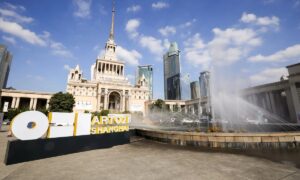
As the 1-54 Contemporary African Art fair opened its fifth edition in Marrakech on Thursday (8 February), its 27 exhibiting gallerists were keen to proclaim what a destination the city has become for buying and selling art. More importantly, collectors and other supporters backed up those words with actions on the expo’s first VIP day.Marrakech may seem a likely hub for the art trade given its long-held status as an international culture and tourism hotspot. However, until recently the majority of Morocco’s commercial galleries were based in the port city of Casablanca, the country’s economic engine and home to its largest number of millionaires.Most of the eight Moroccan galleries on show at this year’s fair (through 11 February) are still Casablanca-headquartered. But as a vote of confidence in Marrakech, some have opened new spaces in the city of late. These include Galerie 38, which launched its local expansion during the 2023 edition of 1-54 Marrakech, and Loft Art Gallery, which inaugurated its new three-storey space there on Thursday. The buzz inside and outside the expo itself made these long-term moves look prescient.The exterior of La Mamounia hotel, the main site of the 2024 edition of the 1-54 Contemporary African Art Fair in Marrakech. Copyright Salah Bouade, courtesy of 1-54 Contemporary African Art FairGrowing internationalismCompared to Casablanca, the crowd in Marrakech is more international, says Yasmine Berrada Sounni, the co-founder of Loft Art Gallery. In Casablanca, she says, the audience generally favours more “fun” works over political art. In Marrakech, however, there is an appetite for more “serious, cultural” practices, she adds.On the gallery’s stand are works from the Ivorian artist Joana Choumali, the Moroccan-Belgian photographer Mous Lamrabat and the Moroccan artists Amina Rezki and Othmane Bengebara. On opening day, the gallery sold three works by Bengebara—two for €8,000 each, and one for €4,200—as well as two pieces by Rezki for undisclosed prices.Many newcomers to the fair seemed surprised by its international audience, particularly since some first-time exhibitors had curated their booths with a primarily Moroccan or North African audience in mind. Gallerists Pratiti Shah and Gabriella Abia Biteo-Talon of the London-based African Art Hub, for example, say that the gallery deliberately chose slightly different works to what they brough to 1-54 in London—less portraiture, more abstraction, it seems—although they are pleasantly surprised by the diversity of 1-54 Marrakech’s audience.Even those who have been exhibiting at this fair since the beginning note its increasingly global character: “When I first exhibited in 2018, I sold a Moroccan artist to a Moroccan collector within the first five minutes,” says Katharina Raab, the owner of her eponymous Berlin gallery.Yet there is also strong representation from within the country and the continent. Touria El Glaoui, the fair’s founding director, says that she is seeing a growing Moroccan audience at the fair. The African Art Hub, meanwhile, is showing works by the Ghanaian artist Sheila Fuseini and the Nigerian artist Gbemileke Adekunle; pieces by both were on reserve by the end of opening day.Sheila Fuseini, Burning Passion (2023). Courtesy of The African Art HubLagos’s Kó gallery, which is also participating in 1-54 Marrakech for the first time, placed an installation piece by the Nigerian artist Ngozi-Omeje Ezema with an unnamed French institutional collection. The work’s price is listed at £18,000, although a discount is being negotiated.Either the same anonymous French institution or another purchased works by Moroccan artists Ali Maimoun and Rita Alaoui featured on the stand of Galerie Siniya 28. The gallery is the only Marrakech-headquartered one exhibiting at DaDa, the cultural and culinary space minted as 1-54’s second site this year.At the entrance of the fair’s main site, the palatial La Mamounia hotel, the Accra-based Gallery 1957 is showing three pieces by one of the most lauded contemporary African artists working today: Amoako Boafo. It is the first time Boafo has shown at 1-54, a decision made in part because of his strong desire to be shown on the continent, say both El Glaoui and Angelica Litta Modignani, Gallery 1957’s associate director. The works, which are on the smaller end for the artist, all found buyers at prices between $150,000 and $200,000 opening day. The gallery also sold three pieces by Rita Mawuena Benissan: two for €15,000 each, and another pair for €12,500 each.Collaboration and curation in the spotlightWith its usual focus on works at midlevel prices, 1-54 Marrakech typically plays host to few blue-chip transactions. However, it does emblematize the palpable collaborative spirit in the African art space.Present at The African Art Hub’s booth was Equatorial Guinea’s minister of culture, who is working with the gallery on a major contemporary art exhibition to be shown in the country. Also seen among the opening-day crowd was Guillaume Cerutti, the chief executive of Christie’s, which is both a global sponsor of 1-54 and the fair’s collaborator on a series of African art auctions. The African art gallerist Ed Cross, the owner of London’s Ed Cross Fine Art, was also spotted working with Space UnTokyo, a new Japan-based arts organisation focused on contemporary African art.Galerie Sinaya 28’s stand at 1-54 Marrakech. Copyright Salah Bouade. Courtesy of 1-54 African Art FairMultiple dealers also spoke of budding cooperation with their fellow exhibitors. Hadia Temlim, the director of Galerie Siniya 28, says the influx of Casablanca galleries to Marrakech has sparked discussions about future gallery weekends and other potential joint projects.International galleries are also pleased by the quality of their fellow exhibitors. Few other fairs have the same “intentionality” as 1-54 Marrakech, says Morenike Adeagbo, the gallery manager of Kó. Shah, of The African Art Hub, agrees that the expo is more curated than most, and that its more intimate scale means the gallery receives more attention than elsewhere, including at the London edition of 1-54. Several gallerists favourably described the fair’s character as “boutique”.Challenges and triumphsDespite the positivity, selling art in Morocco does have its challenges. It is a struggle to secure temporary export licenses here, says Modignani of Gallery 1957. Adeagbo agrees, adding that it is frustrating to have to ship already-sold works back to her gallery in Nigeria before sending them to the collectors who acquired them in Morocco.Concerns larger than red tape also hover in the background: locals are understandably worried about water scarcity as the country approaches its sixth consecutive year of drought, and Morocco is still reeling from the severe earthquake that devastated the Marrakech-Safi region in September 2023.Yet these stressors seemed unable to penetrate the walls of either of the fair’s two sites, and the mood at the close of opening day was celebratory. Gallerists expressed a bashful glee at the size of the crowds and the quality of the art on view.The good vibes carried into Thursday’s collaborative Art Night—a fair-organised, gallery weekend-style event compressed into one evening, where the city welcomed Loft Art Gallery as its newest contemporary art space. Moroccan fairgoers also appreciated an unusual gift from the climate, as Thursday ended with some rare rainfall.While many art professionals on other continents have begun the year by wringing their hands about the state of the trade, on this night at least, Africa felt like more than the global art world’s future. It also felt like the global art world’s present.


























